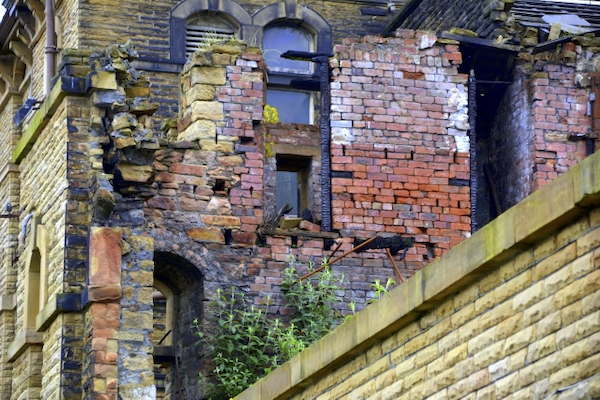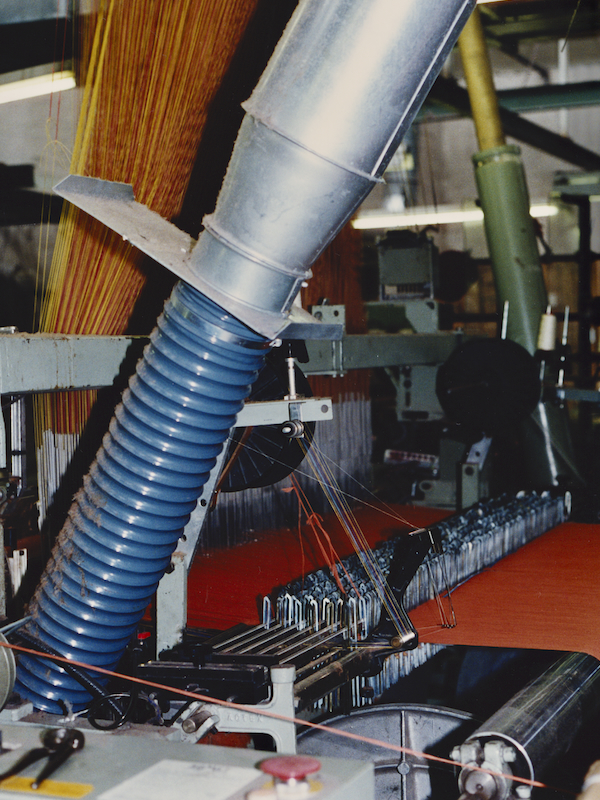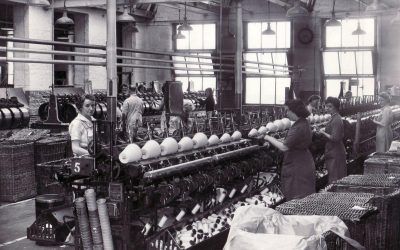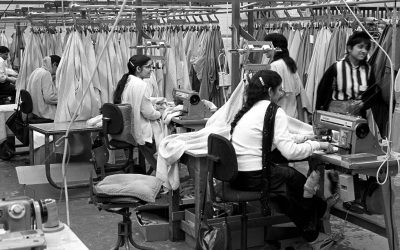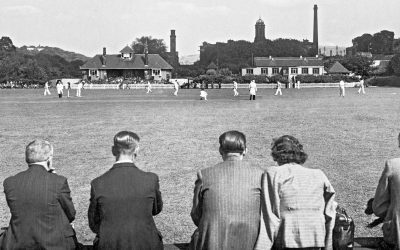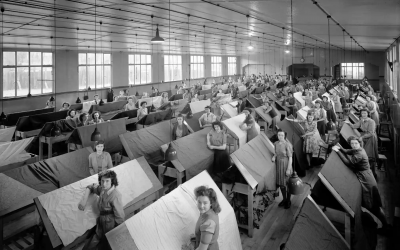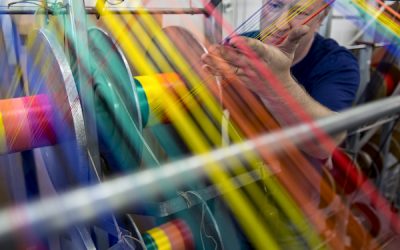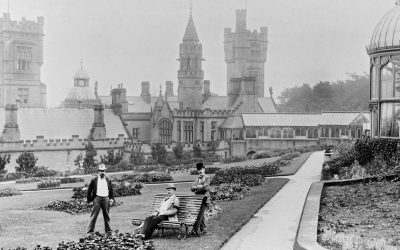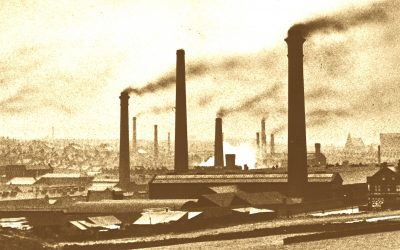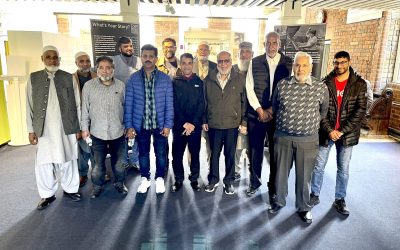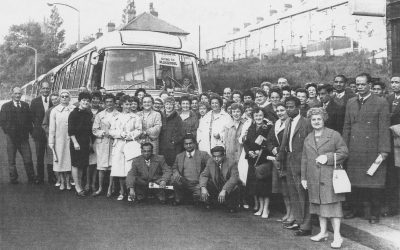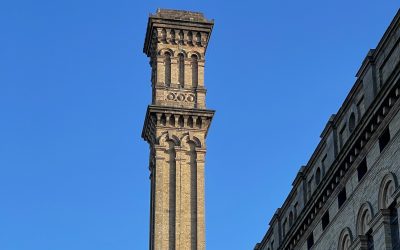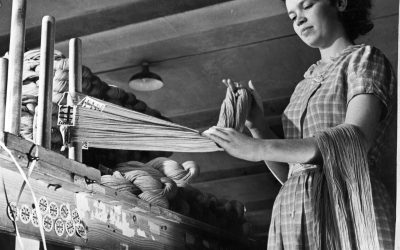I could see at that time that the mills were starting to close around Keighley all over the town and I thought ‘I need to be moving on somewhere’ and that’s when I left in 1975 and joined the fire service.
Automation
Computers and new technology had a huge impact on the textile industry. Automated textile machines were more efficient and less people were required to operate them. Traditional skills were no longer needed and many workers found themselves out of a job.
Some of Bradford’s mills had been using machines that were over 50 years old and when these were no longer needed they were sometimes sold to manufacturers overseas. Factories in China, Vietnam, India, Bangladesh and other countries used cheap labour operating these machines to produce cloth at a very low cost.
In other countries with more advanced technology, there was fierce competition from highly modernised and efficient textile manufacturing. Bradford was in competition with these two competing forces and could win against neither. It was a tough time for the textile trade in Yorkshire.
Importing Turkish Yarn
Elisabeth and Michael Mitchel | Transcript
MM: But when China started, and India started going into textiles, we were selling [them the] machinery. We couldn’t buy the raw material for what they were selling the yarn.
EM: You know when we’re on about the ‘70s?
MM: So that’s why the textile industry went down.
EM: And the mills closing down in the ‘70s? The biggest reason for the decline, locally in Bradford, Keighley, [they’d] started importing Turkish yarn, didn’t they? And once they started importing Turkish yarn…So, a lot of our mills were using natural fibres, weren’t they? Mohair and sheep’s wool. And once they started importing cheap Turkish yarn, they couldn’t compete, could they? They couldn’t compete. So that were beginning of the downfall, wasn’t it? We, you know, people who were involved in mills, we understood that then.
Visiting Drummonds Mill After Closure
Steve Gregson | Transcript
One of the last ones I went to was Drummonds on Lumb Lane. And I was quite upset when that burnt down, because previous to this when the mill was empty, it was empty for a long time, there was an article in the Telegraph and Argus newspaper saying that anybody who had any interest or worked within the textile trade, or that mill, could go and for the last time see it as a non-operational mill before it was made into apartments. And there were 15 of us turned up that day, and the caretaker, for want of a better word, took us on a guided tour of this place for the very last time. And we went up in the lift to the second floor, and when he opened those doors onto the second floor I had a massive flashback, that floor was filled with looms and to see that building… to go in and see that floor with nothing in it… you could have heard a pin drop literally, there was nothing, it was so silent. And it all came back to me when I used to go up and have a look at all the looms going; the smell from the floorboards, the women rushing, the noise and everything.
The Importance of Mosques During Mill Closures
Shaukat Ahmed | Transcript
At that time, all the older people that they were bringing their families over and that was a big shock for them, they brought the family over and they lost their job. So it was really a big crisis time at that time, in their own confidence, in their own self-importance in the family. So, when you are earning the money, you are the boss. Our families are very patriarchal. Father is the boss. And suddenly the boss has become powerless. So, my analysis is that most of the people, who are elderly, they found mosque, religion, they should go to mosque and get their own satisfaction, spiritual satisfaction from. So, Tawakkuliah Mosque played a massive role in terms of defending our community, of giving our elders something to do, somewhere to belong to, once the mills are closed.
Dad’s Redundancy Aged 62
Patricia Crabtree | Transcript
It was sad when the industry started dying. I mean, the business closed down, Dad was made redundant. He was heartbroken, absolutely heartbroken. I mean, he was 62 by that time, so he was coming up to retirement. It’s a shame he didn’t manage to do his last three years. He would have loved to do that. It would have been nice for him to have his last three years and go off with a bang and a party. And it just fizzled out, didn’t it? And I regret the fact that it was such a big, interesting, vibrant industry when I was a little girl and there was so much going for it, and then in the end it just sort of petered out. I think they sold a lot of the looms, I think a lot of them went abroad. He was just sad. He didn’t work again after that. He wasn’t able. He’d worked for the same company all his working life.
Modernising Mill Buildings
From the 1970s onwards, Bradford’s mills were closing rapidly as they struggled to remain economically viable, so these once bustling industrial buildings faced challenges in finding new purposes. Some were redeveloped for residential or commercial use, while others unfortunately fell into disrepair or were demolished due to lack of funding or unsafe architecture from fire damage. This transformation of the mill buildings in Bradford reflects the profound impact of the industry’s decline on the city’s architectural landscape and economic structure.
Now, former mill buildings have been repurposed for various uses. Some have been transformed into residential apartments, providing unique living spaces with historical charm. Others have been converted into office spaces (e.g. Albion Mills), art studios, or cultural centres (e.g. Mind the Gap at Lister’s Mill), contributing to the city’s revitalisation efforts. Additionally, some mill buildings have been preserved as heritage sites, showcasing Bradford’s rich industrial history to visitors and locals alike (e.g. Moorside Mill aka Bradford Industrial Museum). The adaptive reuse of these buildings highlights the city’s ability to blend its industrial past with modern-day needs and aspirations.
Salts Mill is one of the most famous examples of renovating a mill building for artistic purposes, featuring a cafe, bookshop, gallery, plus adaptive exhibition spaces on the top floor. In May 2024, 509 Arts shared a multimedia, live performance exhibit in collaboration with Saltaire Inspired, as part of Saltaire Arts Trail. This exciting commission utilised archive footage, found audio, repurposed content and newly commissioned elements, woven together by the Colour Foundry, to create a rich and immersive environment, bolstered by a freshly composed musical score. Sharing this rich piece of Bradford’s history within a former mill further added to the magical atmosphere of Salts Mill and is definitely a highlight from Lost Mills and Ghost Mansions.
Recovering Documents from Closed Salts Mill in 1986
Colin Hobson | Transcript
I initially approached the company secretary. And he was very helpful. And he said obviously most of it was destined for a West Yorkshire archive, but I could have, you know, basically what I wanted. And I took, there were what they call guard books, which were all the patterns that they’d made, were mounted in a big volume. Which was easily 18 inches thick. They were really big, and it was leather. And as I say, they were called guard books. And they were the reference books for the patterns that they made. And I got about 50 of those and had my father carrying them up from the cellar, and my wife. And then the documentation for… the registering the trademark for the different trademarks. They had about… probably a dozen different trademarks. And so I have the document registering it in Ecuador, Panama, and so on. And really… about 1890, 1900 something like that.
From the 1970s onwards, Bradford’s textile industry underwent a significant decline and Over three decades, once-thriving mills began to close as global competition, changing fashions, and new technology all took their toll. Thousands of jobs were lost, hundreds of mills closed and with the loss of its leadership in textile production, Bradford’s identity and its industrial landscape was reshaped forever.
The impact of New Technology
Jentilal Mistry | Transcript
JM: Well, after the new machinery. Textile, you know, spinning, twisting,
LMI: New machinery came in?
JM: Came in.
LMI: What was that like?
JM: Then the people started losing their job. These people, instead of handling two machines, they moved to four machines.
LMI: One person was looking after two machines.
JM: Two machines. And they started, you know, on and on, going harder and harder.
LMI: So, were they actually making people redundant?
JM: Yeah. That’s the story.
E&S Smiths Trialing New Computerised Jacquard Machines
Richard Smith | Transcript
Our skill set was weaving Jacquard furnishing fabrics. So we weren’t a worsted or wool weaver, which the rest of our contemporaries in Bradford were involved with. We wove pattern fabrics for wholesalers. And Dad had been to this trade fair in Milan and seen a British invention, which was a computerised Jacquard machine. Which was a mind-blowing invention because it increased the speed of the production of fabric, or the number of picks. The method in the 1980s for transferring a pattern into a woven fabric, they used to have to draw out the patterns onto graph paper which was transferred into the punch cards that the looms read. But computer aided design came along in the early 1980s, and this is what my dad had seen initially. So this time-consuming process of doing the designs suddenly, with this computer-aided design equipment, that could be done an awful lot quicker. And the British mills, particularly in the Aire Valley… we were very fortunate to be in the right country for the developer of the computer Jacquard invention, which… They were based in Gateshead, called Bonas Machine Company. And so, they needed to prove their invention, and what better way of trial… letting the local mills trial this new invention? So the Aire Valley, there were several mills: Ourselves, a company called Downs Coulter in Thornton. And the real pioneering company – a tie weaver, a silk and school tie weaver called Masons in Skipton, they had the first prototypes of this modern computer technology. It offset the cost of the designs. We were suddenly more competitive. Although you still have to invest in the new technology, which the government helped with grants for. It enabled us to respond quicker than the foreign mills. It was a window of about three to five years where the British mills got this leg up with the technology, that enabled them to defend their order base, if you like.
New Machinery at British Mohair Spinners
Michael Mitchell | Transcript
I didn’t like being an overlooker. But I am fascinated by processes and how it all worked. Like the people who invented all these machines, and stuff like that. Like… on here now, at this end of the factory, called the Old Mill, they put some brand-new machinery in, and I were in charge of it. And it was called ASD -Uniflex. And that was…rather than, like we said with bit drawing, all them operations, it cut down to three operations in the drawing, rather than seven.
Social & Political Impacts
In the 1980s and 1990s two economic recessions hit Bradford and the north of England very badly. Demand for textiles slumped, made worse by the erosion of the nation’s manufacturing base and a shift to services industries. The globalisation of the world economy drove manufacturing overseas and mills began to close at an ever faster pace.
The devastating loss of jobs across the district brought hardship for many. For decades, the textile industry had been seen as a place of ready employment where you could spend your whole working life if you wanted to. That certainty was gone, and with it the prospect of a regular wage and financial security.
As mills closed, people had to keep moving in search of work. Wages were forced down to control costs and the textile jobs became less and less attractive. Although pockets of manufacturing survived, the end of mass textile production became inevitable and the district was littered with derelict, burnt down or demolished mill buildings.
Many people we interviewed spoke of their pride of working in the mills and their hope that Bradford’s textile legacy would not be forgotten. Richard Smith’s interview discusses the unlikely impact 9/11 had on international textile trade, and contributed to the closure of his family company, E&S Smith.
The Personal Impact on Redundancy on His Workforce
Roger Davy | Transcript
It was a bit of a panicked time. We found that the… if the waste merchants had been buying from the large manufacturers, a lot of the manufacturers were going out of business. People like W & J Whitehead at Laisterdyke, they were a very big company, they were spinners. And all that work stopped. And so it got it got more difficult to to get work. And eventually we ran out of customers, you know. We had a bad recession in the middle ‘70s. And another one… well, two in the ‘80s. And the worst one was about 1988, ‘89 when there was no work coming in at all. And we had a workforce… we had…. [it was a] terrible time for me because I was having to make chaps redundant. Chaps that had been there for years. And there was no option. But we knew they had got families and mortgages and all the rest of it. After travelling every day for 30 odd years from Bradford down to Dudley Hill, I got to the point when I was so worried about the business continuing that I would get to the bottom of Wakefield Road in Bradford, and I felt ‘I can’t go up the hill. I can’t go to the mill.’ And I would turn round that roundabout at the bottom of Wakefield Road and come home again. And quite often I burst into tears. And I was having a bit of a nervous breakdown. And I’m not that sort of person. I didn’t know what was happening. And this went on for about three months, I suppose, and I just got worse and worse. I couldn’t answer the phone. I’d get to the mill sometimes, I’d open the bottom door, and couldn’t go up [to] the mill. I couldn’t go up the stairs. I couldn’t answer the phone. And so, eventually my brother, eldest brother, who came in occasionally, but his two sons were working there, they said, ‘Uncle Roger, go home.’ And so I did. This would be the late ‘90s. And I didn’t go back. I’ve only been back to the mill four or five times since then, because it’s all changed. I think I felt I’d failed but I couldn’t do anything about it.
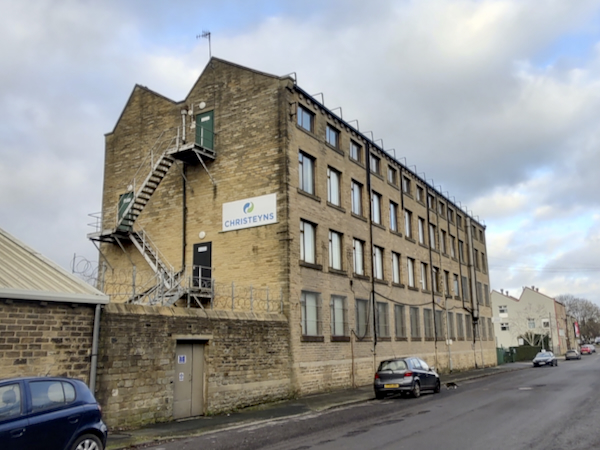
Photograph: Izzie Smith | Victoria Mill of Rutland St, now home to Christeyns UK Ltd (previously Oils and Soaps Ltd, providing chemicals to textile mills in 1980s). This building has been repurposed into offices.
I just think it’s a shame that a lot of them have closed down. I know technology moves on, but for me personally, I’m 55 and I’d like to see a lot of the mills restored as much as possible. I think it’s part of Bradford’s history. The Wool Exchange, that was an amazing place as well.
Watching the Demolition of a Mill Chimney on Thornton Road in the Early 80s
Edo Nannelli | Transcript
I arrived in the country in 1977. And I couldn’t see no… a lot of people getting out of the mills in… the end of the shift, but soon after, I don’t know which year, they closed down altogether. Early ‘80s, I remember. And then there was… because a lot of… I believe on Thornton Road then, that there was a whole line of mills there, they was all demolished at the end of the ‘70s. Also on Thornton Road, I took my son once to see a chimney being demolished one afternoon.
Things to do...

Bradford’s textile industry changed for a variety of reasons over the course of 20-30 years. One thing that has remained, however, is the city’s sense of pride and the legacy from the former wool empire. If you want to learn more, here are some ideas on where to start:
What to do next...
Visit Sunnybank Mills or Salt’s Mill to see how former mill buildings have been repurposed yet still celebrate their textile history.
What to do next...
Are you crafty? Why not learn a new hobby such as knitting, crochet or embroidery. You could personalise your backpack by sewing on a patch, or even make your own scarf!
Discover More
Lost Mills
Lost Mills & Ghost Mansions
Photograph: Tim Smith | UNSPUN How To Use The Learning Zone is a rich and fascinating resource for all. Take your time to explore and discover the many stories and insights on offer. Whether you are a student, a teacher, a researcher, a community group or an...
Working life
Photograph: Tim Smith | Lifting hanks of wool from a dyeing vat at Harrison Gardner and Company. If you've seen old mills, pictures of old mills and that, you'll see that there's a big mill with five or six storeys. And then at the back of it, probably, there's a one...
Diverse workforce
Photographs: Bradford Museums & GalleriesBackground: Bradford Museums & Galleries Photograph: Tim Smith | Combing at Haworth Scouring CompanyBackground: Bradford Museums & Galleries Photograph: Jaz Oldham | Jaz's Sister and Friend working in the mill The...
Time Off
Background: Bradford Museums & Galleries | Cricket Match in Saltaire Photograph: Jaz Oldham | Party in the MillBackground: Bradford Museums & Galleries | Cricket Match in Saltaire Photograph: Patricia Crabtree | Harold Heppleston, Patricia's Father, and...
Rights & Wrongs
Photograph: Val Rowland | Anwar Hussain (L), Bill Morris, former General Secretary of the Transport and General Workers Union (C), and Muhammad Rasab (R). Representing the racial discrimination case against John Haggas Ltd onstage at the Trade Union Annual Congress...
Textiles Today
Background Photograph: Tim Smith | Laxtons' state-of-the-art spinning machinery in Baildon Title Photograph: Tim Smith | Weaving of Rainbow Ribbons at Wyedean Weaving in Haworth In 2022, I saw this job. And I rang them up and said ‘I’m looking for a job as a...
Ghost Mansions
I know that Robert Clough - he had a big mansion, and he donated a Christmas tree for the people of Keighley one year. Well, I won't be swayed on this at all. Particularly on a Friday night, when everybody else had gone home,...
Research & Map
Background Photograph: Bradford Museums & Galleries | Bradford's Skyline Title Photograph: Rainbow School | Visiting Bradford's Industrial Museum I grew up next to Marriner’s and I actually watched it burn down. It would have been in the ‘70s. I was in my...
Do It Yourself
Photograph: Alan Dix | Sangat Centre at Bradford Industrial Museum I think what people should do is show an interest in local history because one day (and I hope this never happens) there won’t be people like you, and there won’t be people like me, who...
Mediawall
Photograph: Margaret Dobson via Keighley and District Local History Society | Employees of John Haggas Ltd's Outing to Blackpool Lost Mills Media Wall Here we celebrate the rich visual history shared by contributors and project partners whilst researching Bradford's...
Archive
Photograph: Alan Dix | Lister's Mill ChimneyWelcome to the Lost Mills Archive. Here you will find all the recordings and transcripts that have been made during the lifetime of the project. It contains a wealth of information - far more than we could ever use in the...
Contributors
Thank you Lost Mills and Ghost Mansions has involved at least 500 people one way or another and their support, participation and commitment has taken us on a very special journey. Most of the people we interviewed were in their 70s and 80s and some were over 90. It is...
The contents of the 509 Arts website are protected by copyright unless otherwise stated. The Lost Mills Learning Zone recordings, text and activity suggestions are free to use for non-commercial community and education purposes. If you wish to use the materials for any other purpose, email info@509arts.co.uk with your plans.
Some of the images and video footage belong to a third party and are credited as such. If you wish to use any such content, please contact 509 Arts or the copyright owner directly.

